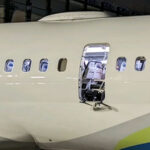Aviation and air travel is all about systems of redundancy. The idea being, that the stakes are too high for a single point of failure. It’s everywhere – throughout design, manufacturing, as well as operation. Name it, you have redundant hydraulic lines and systems, you have processes of inspection and you have two pilots (or more).
There are many stories of how pilots have found solutions to patch together their available systems in catastrophic events to avert disaster entirely or lessen loss of life. One such example is United Airlines 232.
On this flight on July 19, 1989 from Denver’s stapleton airport to Chicago. (note I have flown on this flight) The 3rd engine (tail mounted) suffered a catastrophic failure where a fan disk disintegrated and tore through the number 2 hydraulic system. This cut two hydraulic lines. There are 3 hydraulic systems on the DC-10 and all of them showed zero level of hydraulic fluid. Attempts were made to engage auxiliary pumps, to no avail. The fluid had left the system. The control surfaces of the aircraft rely on these systems and they were gone. Typically a total hydraulic failure could be remedied by a small ram air fan that is deployed from the plane’s belly to generate power to move the fluid but again the fluid was gone. The control sticks in the cockpit were useless.
That is a multi system failure but here another redundant system took over. That system was the pilots leveraging independent throttling of the two remaining wing mount engines. With ATC keeping other traffic away, the pilots were able to learn to fly and control the aircraft and put it on course for an emergency landing in Souix City, Iowa.
The flight crew experienced numerous other knock-on failures on approach and ultimately the plane experienced a roll seconds from touchdown that could not be fully remedied. The resulting landing was a crash. The plane cartwheeled in flames before finally coming to a rest in pieces on runway 22. 296 people were on the plane, 184 survived.
It’s a miracle that anyone survived, but it’s by design that total disaster was averted, although the heroics employed by the captain, first officer and flight engineer put Sully Sullenberger to shame.
Boeing’s latest “mistake” is that a door plug – basically a bolted cover of a hole used for an emergency exit in a different configuration – was not fastened correctly during the manufacturing process. This plug is invisible to the passenger. It just looks like a normal wall and window inside the plane, but on the outside you can see the outline of a large cut out of the fuselage where an emergency exit could be installed.
It ripped out when the pressure began to increase inside the plane, tearing through the interior cosmetic treatment. This left a perfectly smooth hole large enough to suck out rows of passengers simultaneously. Luckily, the plane was not at cruising altitude, so the decompression was not explosive. There were also no passengers in the two seats adjacent to the hole. Had the plane been at cruising altitude explosive decompression would have occurred, meaning the percussive nature of the event likely would have dislodged seats, unbelted passengers, and potentially compromised the fuselage. Death results in all of those scenarios to varying degrees. Everyone was very lucky.
Boeing’s CEO called this a mistake. To call this mistake undercuts the principle of redundancy because mistakes, if they happen, are found and remedied as part of the methodology of manufacturing. A mistake might have been not installing the correct bolts, it could have been not inspecting those bolts, it could have been not tightening the bolts to the required torque, it could have been not inspecting the inspection checklist. The system is what failed because the system is designed to self correct. If the system failed, then the system is broken and if it’s broken then any number of other failures could exist across the system of the aircraft and that means failure is possible to an unknown factor.
Boeing has been troubled by reckless shortcuts, talent loss and leadership failures. But it’s latest declaration of this systematic failure is all you need to see here. The system is broken and needs to be rebuilt. A fool would trust a broken system and a fool would put confidence in a leader who cannot articulate this, is hiding this or possibly doesn’t even see it.
If your business is churning customers you have a catastrophic failure of systems. You are losing more money than you are taking in. Without a cash infusion you will crash. Right now, interest rates are high and valuations are down. You aren’t likely to get it.
Your revenue engine is a system. It needs to attract customers with business challenges, your product must be capable of solving those challenges, you must define metrics against those outcomes so you know what success looks like to your customers and you must efficiently guide customers throughout their lifespan to to achieve those metrics – and prove it. If that happens, your customers will renew and expand. Disaster averted.
If you are experiencing the telltale signs of a systematic failure, you need to rebuild your system and need the leadership to do it. Retain altitude and airspeed while course correcting. If you’d like to learn more, give me a follow or contact me here.



